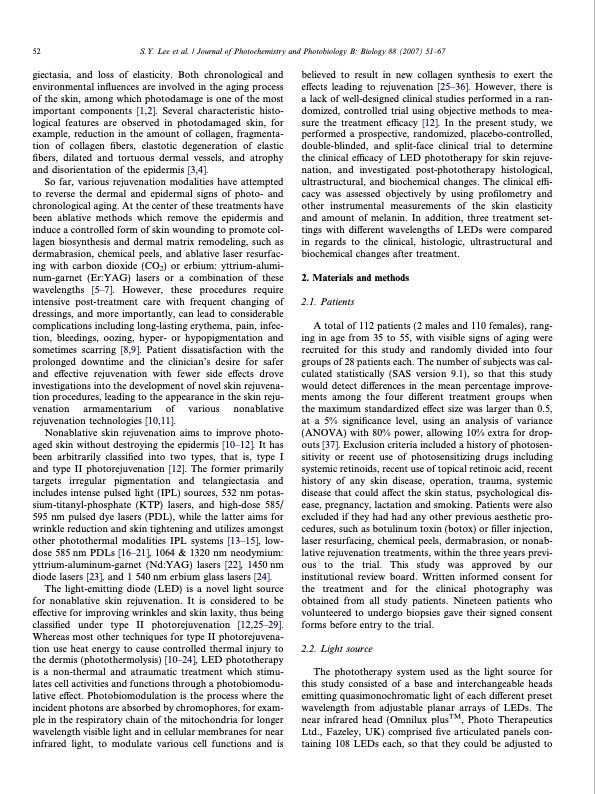
PDF Publication Title:
Text from PDF Page: 002
52 S.Y. Lee et al. / Journal of Photochemistry and Photobiology B: Biology 88 (2007) 51–67 giectasia, and loss of elasticity. Both chronological and environmental influences are involved in the aging process of the skin, among which photodamage is one of the most important components [1,2]. Several characteristic histo- logical features are observed in photodamaged skin, for example, reduction in the amount of collagen, fragmenta- tion of collagen fibers, elastotic degeneration of elastic fibers, dilated and tortuous dermal vessels, and atrophy and disorientation of the epidermis [3,4]. So far, various rejuvenation modalities have attempted to reverse the dermal and epidermal signs of photo- and chronological aging. At the center of these treatments have been ablative methods which remove the epidermis and induce a controlled form of skin wounding to promote col- lagen biosynthesis and dermal matrix remodeling, such as dermabrasion, chemical peels, and ablative laser resurfac- ing with carbon dioxide (CO2) or erbium: yttrium-alumi- num-garnet (Er:YAG) lasers or a combination of these wavelengths [5–7]. However, these procedures require intensive post-treatment care with frequent changing of dressings, and more importantly, can lead to considerable complications including long-lasting erythema, pain, infec- tion, bleedings, oozing, hyper- or hypopigmentation and sometimes scarring [8,9]. Patient dissatisfaction with the prolonged downtime and the clinician’s desire for safer and effective rejuvenation with fewer side effects drove investigations into the development of novel skin rejuvena- tion procedures, leading to the appearance in the skin reju- venation armamentarium of various nonablative rejuvenation technologies [10,11]. Nonablative skin rejuvenation aims to improve photo- aged skin without destroying the epidermis [10–12]. It has been arbitrarily classified into two types, that is, type I and type II photorejuvenation [12]. The former primarily targets irregular pigmentation and telangiectasia and includes intense pulsed light (IPL) sources, 532 nm potas- sium-titanyl-phosphate (KTP) lasers, and high-dose 585/ 595 nm pulsed dye lasers (PDL), while the latter aims for wrinkle reduction and skin tightening and utilizes amongst other photothermal modalities IPL systems [13–15], low- dose 585 nm PDLs [16–21], 1064 & 1320 nm neodymium: yttrium-aluminum-garnet (Nd:YAG) lasers [22], 1450 nm diode lasers [23], and 1 540 nm erbium glass lasers [24]. The light-emitting diode (LED) is a novel light source for nonablative skin rejuvenation. It is considered to be effective for improving wrinkles and skin laxity, thus being classified under type II photorejuvenation [12,25–29]. Whereas most other techniques for type II photorejuvena- tion use heat energy to cause controlled thermal injury to the dermis (photothermolysis) [10–24], LED phototherapy is a non-thermal and atraumatic treatment which stimu- lates cell activities and functions through a photobiomodu- lative effect. Photobiomodulation is the process where the incident photons are absorbed by chromophores, for exam- ple in the respiratory chain of the mitochondria for longer wavelength visible light and in cellular membranes for near infrared light, to modulate various cell functions and is believed to result in new collagen synthesis to exert the effects leading to rejuvenation [25–36]. However, there is a lack of well-designed clinical studies performed in a ran- domized, controlled trial using objective methods to mea- sure the treatment efficacy [12]. In the present study, we performed a prospective, randomized, placebo-controlled, double-blinded, and split-face clinical trial to determine the clinical efficacy of LED phototherapy for skin rejuve- nation, and investigated post-phototherapy histological, ultrastructural, and biochemical changes. The clinical effi- cacy was assessed objectively by using profilometry and other instrumental measurements of the skin elasticity and amount of melanin. In addition, three treatment set- tings with different wavelengths of LEDs were compared in regards to the clinical, histologic, ultrastructural and biochemical changes after treatment. 2. Materials and methods 2.1. Patients A total of 112 patients (2 males and 110 females), rang- ing in age from 35 to 55, with visible signs of aging were recruited for this study and randomly divided into four groups of 28 patients each. The number of subjects was cal- culated statistically (SAS version 9.1), so that this study would detect differences in the mean percentage improve- ments among the four different treatment groups when the maximum standardized effect size was larger than 0.5, at a 5% significance level, using an analysis of variance (ANOVA) with 80% power, allowing 10% extra for drop- outs [37]. Exclusion criteria included a history of photosen- sitivity or recent use of photosensitizing drugs including systemic retinoids, recent use of topical retinoic acid, recent history of any skin disease, operation, trauma, systemic disease that could affect the skin status, psychological dis- ease, pregnancy, lactation and smoking. Patients were also excluded if they had had any other previous aesthetic pro- cedures, such as botulinum toxin (botox) or filler injection, laser resurfacing, chemical peels, dermabrasion, or nonab- lative rejuvenation treatments, within the three years previ- ous to the trial. This study was approved by our institutional review board. Written informed consent for the treatment and for the clinical photography was obtained from all study patients. Nineteen patients who volunteered to undergo biopsies gave their signed consent forms before entry to the trial. 2.2. Light source The phototherapy system used as the light source for this study consisted of a base and interchangeable heads emitting quasimonochromatic light of each different preset wavelength from adjustable planar arrays of LEDs. The near infrared head (Omnilux plusTM, Photo Therapeutics Ltd., Fazeley, UK) comprised five articulated panels con- taining 108 LEDs each, so that they could be adjusted toPDF Image | LED phototherapy for skin rejuvenation

PDF Search Title:
LED phototherapy for skin rejuvenationOriginal File Name Searched:
LED-phototherapy-for-skin-rejuvenation.pdfDIY PDF Search: Google It | Yahoo | Bing
Cruise Ship Reviews | Luxury Resort | Jet | Yacht | and Travel Tech More Info
Cruising Review Topics and Articles More Info
Software based on Filemaker for the travel industry More Info
The Burgenstock Resort: Reviews on CruisingReview website... More Info
Resort Reviews: World Class resorts... More Info
The Riffelalp Resort: Reviews on CruisingReview website... More Info
| CONTACT TEL: 608-238-6001 Email: greg@cruisingreview.com | RSS | AMP |